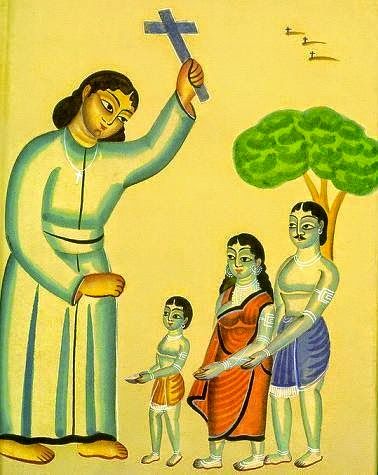There has been a concerted effort by Christian evangelists and their stooges in India to sever the bonds of history, tradition and culture that unite the Northern and Southern parts of the country. On way in which this has manifested itself in this whole ‘Dravidian nationalism’ theory which posits that Dravidians were the original inhabitants of India and were displaced by the war-like Aryan tribes who then imposed their culture on the country. The theory has been taken to ridiculous limits and Dravidian activists have vented their ire on Sanskrit and Brahmins, who are portrayed as Aryan agents. In doing so, Dravidianists are basing their actions on a widely-discredited Aryan invasion theory and are doing a great disservice to the years of interaction and symbiosis between Sanskrit and Tamil which has enriched both languages. The biggest irony perhaps is the fact that the word ‘Dravida’ itself doesn’t appear in Tamil language and is derived from Sanskrit, where it simply means Southern. There is no mention of Aryan invasion in Tamil literature and cultural similarities between Tamil and “North Indian” culture are so apparent that talks of a Tamil culture, antagonistic to the culture prevalent in rest of the country are simply bunkum.
Rajiv Malhotra and Aravindan Neelakandan in their seminal work ‘Breaking India‘, have been able to compile multiple sources how Colonial masters and Christian Evangelists colluded to distort India’s history to create a separate Dravidian identity, inimical to the idea of India.
This theory was then espoused by Periyar and his Dravidian coterie.
Once in power, Tamil Nadu’s Dravidian parties have practiced a brand of politics that has encouraged this separatist identity by positioning rumours, half truths and abject lies as gospel truths.
For example, Robert Caldwell, colonial-era linguist and academician, who has been honored with a statue on Madras Marina since 1967, is widely recognized with the ‘indigenous Dravidians, invading Aryans theory’. His primary concern, however, does not seem to be academic, but in fact “was to convert the south Indians to Christianity”, by breaking the stranglehold of Brahmins. Native converts subsequently worked with the missionaries and evangelists to de-Hinduize (the word formally used is Secularize) Tamil literature. People like Deivanayagam, referred to multiple times by Malhotra, took this theory to a completely different level by positioning Dravidian culture as being Christian, before the Brahmins and invading Aryans imposed polytheistic Hinduism on the natives.
St. Thomas is popularly believed to have visited the Southern part of the country and proselytized there. There are also claims that he was murdered by the Brahmins. There exists no proof for the same and even Pope Benedict XVI has denied that St. Thomas did indeed visit South India. Facts however are immaterial to Evangelists and their native lackeys.
There are claims that the great Tamil poet, Thiruvalluvar was a Christian and a disciple of St. Thomas. Not only that, the concepts of Thiruvalluvar are claimed to be a representation of the Bible. Hindu concepts are re-imagined and represented in Christian terms. Shaiva Siddhanta, for instance is described in Christian terms. Instead of a Hindu religion, of which Thiruvalluvar and Shaiva Siddhanta are integral parts, a new “ancient Tamil religion” is propounded, the one that was pure before the Aryans laid waste to it. The trimurti of Shiva-Murugan-Shakti or Brahma-Vishnu-Mahesh is recast as the holy trinity.
Superficial similarities are used to show the commonalities between Christianity and ancient Tamil texts while Hinduism is denigrated for all societal ills. Deivanayagam and his ilk have organized international conferences in which they have presented research papers on bogus subjects by referencing works done by each other, thereby claiming credibility. Unfortunately, successive governments in Tamil Nadu, fired up by an imaginary Dravidian identity have encouraged such crackpots, much to the detriment of national unity. Aided by an omnipotent church and fired by Church’s money, baseless theories of no scientific veracity are now propagated as research and evidence.
This has resulted in several laughable and embarrassing outcomes. Fired by their zeal to prove the antiquity of their culture, some Dravidianists were hooked on to the concept of Lemuria or Kumari Kandam, which stretched from the coast of Africa to Australia. This was then claimed to be the home of Hom o Dravida and Kumari Kandam was described as a proto-Dravidian urheimat, all of which was subsequently dismissed as falsehood. This is not all, blinded by their enthusiasm, some Dravidianists proposed that Aryans were originally Dravidians who went to the West, were corrupted and invaded India. Others describe Sanskrit emerging as a language in an era after the birth of Christ. Sadly, many of these theories are in vogue in mainstream discourse.
In 1945, scrolls emerged at Nag Hammadi in Egypt. These scrolls contained the gospel of St. Thomas, a gnostic and potentially heretic text. Some parts of the text resonate with vedic concepts and themes, leading to claims that instead of Hinduism or ‘ancient tamil religion’ having originated from Christianity, it might be the other way round. ‘Jesus lived in India’ is anyways an age old theory that has attracted academic interest. Clearly, Dravidianists are mere pawns in the hands of the Church and evangelists to win India for the Christ through nefarious deeds. They must be challenged at each stage and their true faces revealed.
